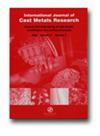重型自动变速器油线路板压铸工艺设计与优化
IF 1.1
4区 材料科学
Q3 METALLURGY & METALLURGICAL ENGINEERING
International Journal of Cast Metals Research
Pub Date : 2021-03-04
DOI:10.1080/13640461.2021.1904673
引用次数: 2
摘要
本研究将高压直流成形技术引入到油线板的生产中,旨在解决成型缺陷,为大型铸件压铸工艺的开发提供完整的设计理念。首先,设计了压铸模具并验证了模具的合理性,但由于注塑工艺参数的选择不合理,导致铸件不合格。其次,以田口法L25正交阵列的实验数据作为训练样本,考察了压铸件的孔隙率与铸造变量参数的关系。具体来说,主要研究了速度、温度和注射压力,数学模型通过了精度检验。最后,利用粒子群优化算法(PSO)对模型进行优化,实现孔隙度最小。结果表明,粒子群优化算法的优化结果优于田口方法的优化结果,比预优化结果有显著改善。本文章由计算机程序翻译,如有差异,请以英文原文为准。
Design and optimisation of die casting process for heavy-duty automatic transmission oil circuit board
ABSTRACT In this study, HPDC is introduced into the production of oil circuit board, aiming to solve forming defects and provide a complete design concept for the exploitation of die-casting process in large castings. First, the die-casting die was designed and its rationality was verified, but the unreasonable selection of injection process parameters caused casting non-conformance. Next, the experimental data of L25 orthogonal array of Taguchi method were used as training samples and the porosity of the die-cast part was examined in relation to casting variable parameters. Specifically, the velocity, temperature and injection pressure were mainly investigated, while the mathematical model passed the test of accuracy. Finally, Particle Swarm Optimisation (PSO) algorithm was used to optimise the model, achieving minimum porosity. The results have shown that the PSO algorithm optimisation results are better than the one produced by the Taguchi method, providing a significant improvement over the pre-optimisation results.
求助全文
通过发布文献求助,成功后即可免费获取论文全文。
去求助
来源期刊
CiteScore
2.70
自引率
7.10%
发文量
14
审稿时长
7.5 months
期刊介绍:
The International Journal of Cast Metals Research is devoted to the dissemination of peer reviewed information on the science and engineering of cast metals, solidification and casting processes. Assured production of high integrity castings requires an integrated approach that optimises casting, mould and gating design; mould materials and binders; alloy composition and microstructure; metal melting, modification and handling; dimensional control; and finishing and post-treatment of the casting. The Journal reports advances in both the fundamental science and materials and production engineering contributing to the successful manufacture of fit for purpose castings.

 求助内容:
求助内容: 应助结果提醒方式:
应助结果提醒方式:


